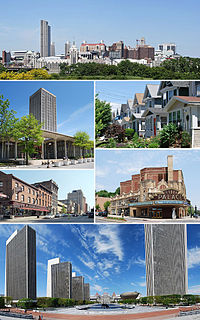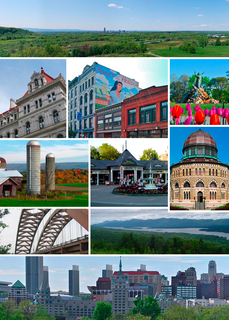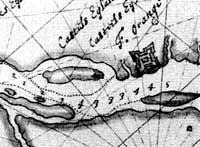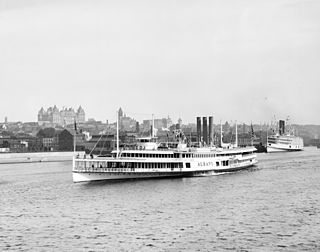
Albany County is a county in the state of New York, United States. Its northern border is formed by the Mohawk River, at its confluence with the Hudson River, which is to the east. As of the 2020 United States Census, the population was 314,848. and largest city is Albany, the state capital of New York. As originally established by the English government in the colonial era, Albany County had an indefinite amount of land, but has had an area of 530 square miles (1,400 km2) since March 3, 1888. The county is named for the Duke of York and of Albany, who became James II of England.

Albany is the capital of the U.S. state of New York, and the seat and largest city of Albany County. Albany is on the west bank of the Hudson River, about 10 miles (16 km) south of its confluence with the Mohawk River, and about 135 miles (220 km) north of New York City.

Albany International Airport is six miles (9 km) northwest of Albany, in Albany County, New York, United States. It is owned by the Albany County Airport Authority. ALB covers 1,000 acres (400 ha) of land.

Colonie is a town in Albany County, New York, United States. It is the most-populous suburb of Albany, and is the third-largest town in area in Albany County, occupying approximately 11% of the county. Several hamlets exist within the town. As of the 2010 census, the town had a total population of 81,591.

The Capital District, also known as the Capital Region, is the metropolitan area surrounding Albany, the capital of the U.S. state of New York. In the 21st century, the Capital District emerged as a major anchor of Tech Valley, the moniker describing the technologically-focused region of eastern New York State. The Capital District was first settled by the Dutch in the early 17th century and came under English control in 1664. Albany has been the permanent capital of the state of New York since 1797. The Capital District is notable for many historical events that predate the independence of the United States, including the Albany Plan of Union and The Battles of Saratoga.

Erastus Corning 2nd was an American politician. A Democrat, Corning served 72nd as mayor of Albany, New York from 1942 to 1983, when Albany County was controlled by one of the last classic urban political machines in the United States.

Edwin Corning was an American businessman and politician from New York. He was Lieutenant Governor of New York from 1927 to 1928.

Parker Corning was an American businessman and politician from Albany, New York. He is most notable for his service as a United States Representative from New York from 1923 to 1937.

Castle Island is a former island located in the city of Albany, Albany County, New York. Over the past 400 years, Castle Island has been referred to as Martin Gerritse's Island, Patroon's Island, Van Rensselaer Island, and—since the late 19th century--Westerlo Island. The land known as Castle Island has been connected to the mainland and now forms a part of the Port of Albany.
The history of Albany, New York began long before the first interaction of Europeans with the native Indian tribes, as they had long inhabited the area. The area was originally inhabited by an Algonquian Indian tribe, the Mohican, as well as the Iroquois, five nations of whom the easternmost, the Mohawk, had the closest relations with traders and settlers in Albany.
The town of Watervliet was a town that at its height encompassed most of present-day Albany County and most of the current town of Niskayuna in neighboring Schenectady County, in the state of New York, United States. Just prior to its dissolution, the town encompassed the current towns of Colonie and Green Island and the city of Watervliet.

The history of Albany, New York from 1784 to 1860 begins with the ratification of the Treaty of Paris by the Congress of the Confederation in 1784 and ends in 1860, prior to the American Civil War.

The history of Albany, New York from 1942 to 1983 begins with the beginning of the tenure of Erastus Corning 2nd as mayor and ends with Corning's death in 1983.
The history of Albany, New York from 1983 to present begins with the death of Erastus Corning 2nd, Albany's longest serving mayor. When Corning died in 1983, Thomas Whalen assumed the mayorship and was reelected twice. Albany saw a significant influx of federal dollars earmarked for restoring historic structures. What Corning had saved from destruction, Whalen refurbished. The Mayor's Office of Special Events was created in an effort to increase the number of festivals and artistic events in the city, including a year-long Dongan Charter tricentennial celebration in 1986. Whalen is credited for an "unparalleled cycle of commercial investment and development" in Albany due to his "aggressive business development programs".

Philip Schuyler Van Rensselaer was the mayor of Albany, New York on two occasions. He has the third longest tenure of service by an Albany Mayor, after Erastus Corning 2nd and Gerald Jennings.

William Stormont Hackett was an American lawyer, banker, businessman and politician. A Democrat, he was most notable for serving as 70th mayor of Albany, New York after winning an election in 1921 that ended control of Albany by the Republican organization headed by William Barnes, and established the dominance of the Democratic organization led by Daniel P. O'Connell and Edwin Corning.

Edwin Corning Jr. was an American businessman, United States Navy officer and Democratic politician from Albany, New York. A member of the prominent Corning family, he was most notable for his service as a member of the New York State Assembly from 1955 to 1959.

Elections are held every four years in the off-year immediately after United States presidential election years in Albany, New York to elect the city's mayor.

















